Luxury goods companies learn to mix craft and tech
Roula Khalaf, Editor of the FT, selects her favourite stories in this weekly newsletter.
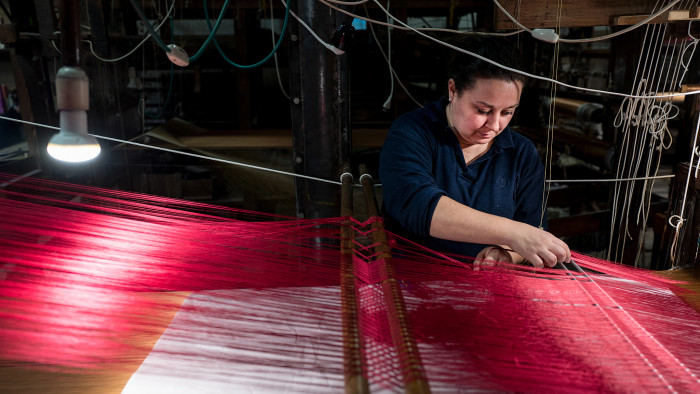
There is a factory in Venice on the Grand Canal where it seems time stopped still two centuries ago. Workers at Tessitura Luigi Bevilacqua make damask and jacquard fabrics on 18th-century looms. Inside the faded palazzo the sound of the canal waters lapping outside the front door alternates with that of the clanking wooden looms inside.
“You do not get the same effect if you use mechanical looms,” says Alberto Bevilacqua as he watches two younger female colleagues heave themselves forward to push the wooden beams back and forth. The weave is deeper and richer as a result of the hand process, he argues.
The commitment of the Bevilacqua family and their seven weavers to the two-centuries-old jacquard process has its part in a roiling debate about the future of European craft in the face of new technologies. Alberto Bevilacqua, the company’s chief executive, whose family dates its occupation in textiles to 1499, is on one side of the argument. His embrace of innovation ended with Jacquard’s loom, a mould-busting invention in its day, awarded a patent in 1805 by Emperor Napoleon for its punch-card mechanism.
On the other side, European craft manufacturers, from makers of luxury handbags and eyewear to those of high-end furniture and even supercars, are embracing the future. They are exploring how much frontier technology, such as 3D printing, robots and artificial intelligence (AI), they can mix with their craft and still maintain their prestigious and lucrative “Made in Europe” reputation.
“The greatest dilemma faced by the modern artisan craftsman is the machine,” argued Richard Sennett in his influential 2009 book The Craftsman. “Is it a friendly tool or an enemy replacing work of the human hand?”
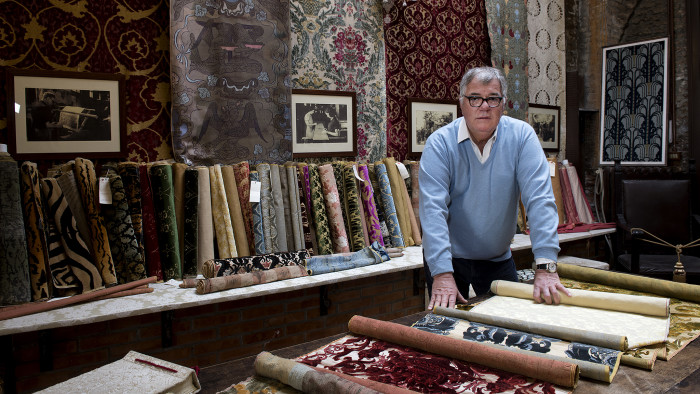
One business attempting to answer that question is the Thélios eyewear factory opened in Italy last year. The plant, a joint venture between French luxury goods group LVMH and Italian eyewear manufacturer Marcolin, is in the Valle de Valjont, a cluster of artisanal eyewear workshops in the shadow of the Dolomite mountains.
In a gleaming white room, technical designers working on Mac computers turn a pencil sketch of sunglasses by Celine designer Hedi Slimane in Paris into precise technical drawings. These are then sent to 3D printers. In an adjacent room, artisans take over, hand-buffing prototypes to a high shine. Giovanni Zoppas, Thélios chief executive, explains that by using 3D printers it now takes less than two hours to turn a designer’s drawing into a physical product.
There is a similar scene at Gucci’s new factory in Scandicci, an industrial zone west of Florence known for its artisanship since the Renaissance. In one room a robot makes $650 training shoes. The patented machine, dubbed Reingenious, manipulates and assembles the footwear. It saves human workers “handling and stress”, a Gucci guide says during a tour of the site.
In the next room, though, are artisans bending Gucci’s signature bamboo handles by hand over a naked flame and hand-painting designs of birds and bees on handbags created by chief designer Alessandro Michele. Gucci, owned by France’s Kering group, reckons only 30-35 per cent of its production can be completely automated — the rest needs some human input.
Gucci chief executive Marco Bizzarri is alive to tech threats, however. He recently told reporters that “3D technology would be a big change in development and prototyping, and even production”. He is also keeping an eye on “in vitro” growth of leathers (laboratory-produced material), a development that would eradicate the need for tanneries.
Handcraftsmanship will always be an important reason why people pay outsized amounts to own or access luxury goods, argues Robert Wolcott, clinical professor of innovation and entrepreneurship in executive education at Kellogg School of Management, Northwestern University, near Chicago.
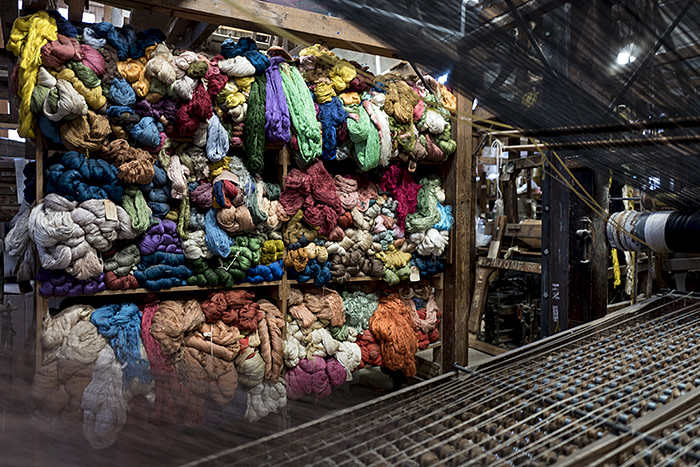
It is wrong, however, to imagine all luxury goods will be produced in this manner in the future, he says. Consumers will probably continue to prize handmade products, he adds, while also valuing exceptional, exciting, provocative goods and experiences created by new means, from robots and 3D printers to AI-based systems. These modes are not mutually exclusive: some of the leading offerings will probably combine both traditional and new modes of production, Wolcott says.
“The key point isn’t necessarily that a luxury good is handmade, but that it is special or distinctive in some way that is significant to affluent consumers. Craftsmanship is one essential path, but it’s not by any means the only one,” he adds.
Many agree. “For a tradition to be kept alive it needs to be constantly reinvented,” says Olivier Brault, director-general of the Paris-based Fondation Bettencourt Schuler, the charitable organisation of the billionaire family behind French cosmetics group L’Oréal.
But others remain wary of encroaching technology. Johann Rupert, chairman of Swiss luxury goods group Richemont, owner of Cartier and Van Cleef & Arpels, argues that European craft needs to be defended to “make sure Europe remains a workshop for the world”. He does not want a dystopian vision of AI and robots to finish off European artisanship, which has already been decimated by globalisation and competition from China.
Through his charitable foundation, Rupert staged an exhibition in September at Venice’s lush Giorgio Cini Foundation titled “Homo Faber: Crafting a More Human Future”, referring to the Renaissance aspiration of “man as maker”. It provided an overview of European fine craftsmanship — from Portuguese lacemakers to Slovak carpentry — and emphasised “what human beings can do better than machines”, says Rupert. “I have been worried for quite a while about the loss of artisanal skills,” he told the FT last month. The exhibition had been such a “real success” it would be staged again in two years, he said.
Still, Wolcott notes that when Henry Ford started producing cars on assembly lines with interchangeable parts, many carmakers and commentators asserted that only the mass market would be served by such lower-quality products. “Today, we still have a few handmade vehicles at the highest end of the market, such as Rolls-Royce, but no one would call a Mercedes S-Class an entry-level vehicle,” he adds.
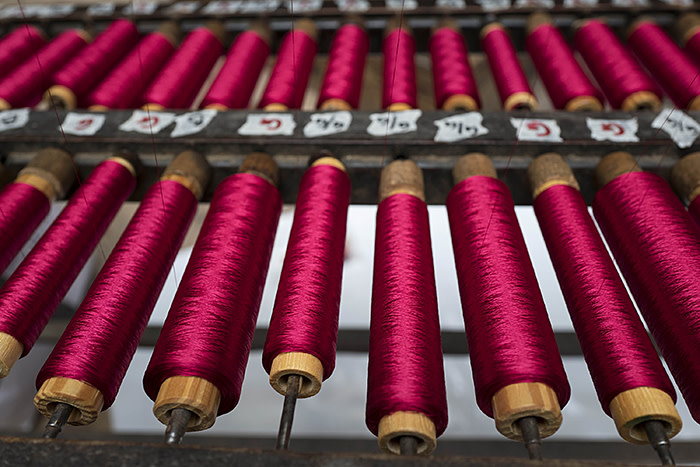
That is certainly the view at Pirelli, the Italian tyremaker that supplies high-end carmakers such as Ferrari, Lamborghini, Maserati and Porsche, as well as all Formula One racing teams. Marco Tronchetti Provera, Pirelli’s chief executive, argues against taking a “defensive approach” to technology as it would “mean we have already lost the battle”. “We need a proactive approach based on memory and culture,” he said in a recent interview.
Pirelli’s flagship plant outside Turin in northern Italy puts this vision into practice. Joining together two previously separate factories, it is arranged on two sides of a spine of offices, cafeteria and football pitch, and was designed by Renzo Piano. Cherry trees line the entrances. On the factory floor, engineers and production staff work side by side with robots. Machines mix the rubber, squeezing it into strips, before these are assembled part by humans and part by machine. No product leaves the factory floor without being inspected by an engineer.
The most sophisticated production, however, is kept behind locked doors. Inside, 48 red robots, each two metres high and animated by AI, make Pirelli’s top-of-class tyres for supercars, doing away with the need for a production line. The tyres are made on a product by product basis: a Ferrari tyre, then a Maserati tyre, then a Lamborghini tyre.
To celebrate the opening of the factory, Tronchetti Provera commissioned a piece of music to symbolise the fusion of the creativity of Pirelli’s engineers with the machine intelligence and skill of workers on the shop floor. “Il Canto della Fabbrica” was performed on the factory floor as the robots whirred.
“The richness of Europe is really something we have forgotten,” Tronchetti Provera argues. “We are the richest region in the world, the manufacturing is the best in the world, we are the most creative, we are the most protected, but if we do not work together more closely, we are at risk of losing it.
“Obviously China invests in AI as a country. You cannot invest in AI as France, Italy, Germany individually. Europe needs to invest as a region, together.”
On the south-western edge of Europe, in the Portuguese coastal city of Porto, there is an indication of how technology could take European craft into the future.
In a low stone building dating from the 18th century, Paula Sousa, founder of Urbanmint and one of Portugal’s rising design stars, has her studios. The space may date from the same period as Bevilacqua’s looms, but there the comparison ends: Sousa is happy to use new technology to disrupt her craft. She is in good company. Nearby are the Porto offices of Farfetch, a London-based online luxury fashion company and one of Europe’s most successful new technology companies.
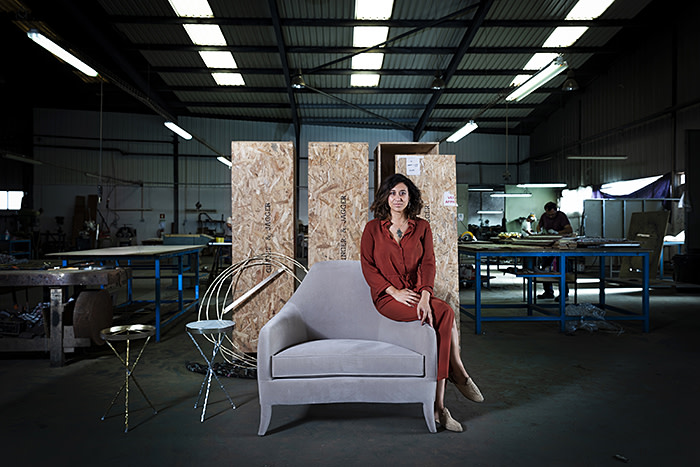
“High technology will improve craft. It gives the human time to produce strategy and planning. So we have time to create and to think more wisely,” says Sousa, flashing a wide smile. She created her two brands, Munna and Ginger & Jagger, during Portugal’s crisis a decade ago when thousands of businesses were going to the wall. A former interior designer, she knew factories in China and Turkey could produce her sofas, mirrors and tables more cheaply but that they did not have the quality of Portuguese craftsmanship.
She took a gamble and went to visit Portuguese industrial jewellery-makers and marble-cutters that were idling or shuttering their business and asked them if, instead, they would consider turning their hand to custom-made furniture. “I said: it is like jewellery but big,” she says, throwing her arms wide as she remembers how she convinced one factory owner. That factory has retooled its metalworking machines, previously rendered redundant by competition from Indian jewellery factories, to make metre-wide gilt mirrors as delicate as rose stems. Each one is finished by hand. Dior, owned by LVMH, has ordered several for its stores.
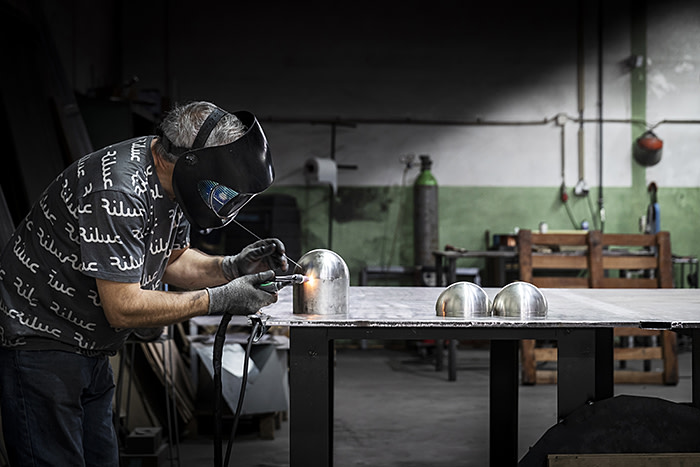
Another example in Porto is Riluc, a manufacturer of stainless steel which, when business dried up a decade ago, reinvented itself as a maker of high-end furniture. Factory owner Ricardo Lucas invited a French designer, Toni Grilo, to imagine new uses for his stainless steel: Riluc’s Bibendum chair sells for €14,000.
“In moments of crisis you start from the ground. Institutions do not solve these problems. It comes from ferment on the ground — you feel that ferment in Portugal,” says Maria Milano, an architect and professor at Porto’s ESAD school of art and design. New technologies mean there “is more creativity than ever before” in Europe, she adds. “Before the crisis, design was all about the centres, like Milan. In recent years designers have been able to be anywhere. They have 3D printing, so they can self-produce, and then they are able to sell via the internet.”

Sousa can see a similar process of evolution at a marble-cutting yard in the green hills above Porto. Computer-controlled machines slice into marble on five axes at a time, creating her Rock table. The table is finished by hand, smoothed to a high shine.
Sousa recently returned from Toledo in Spain, where she met with master masons whose methods are unchanged from the 14th century. While this gave her some inspiration, it was not a solution for her.
“Consumers understand: why should an artisan be doing a mechanical process that can be done by a machine?” says Sousa. Instead, she sees a fusion of designer, artisan and machine creating a new era for European craft. “It is a constellation in the end,” she says. “I am full of hope for the years to come.”
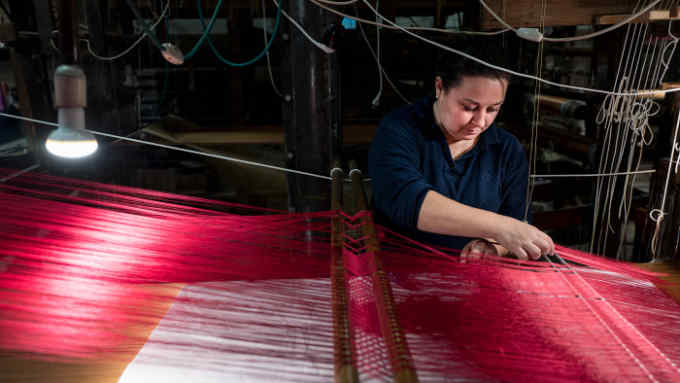
Comments